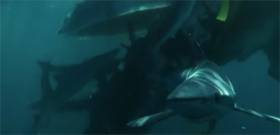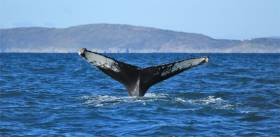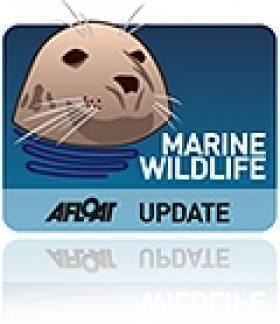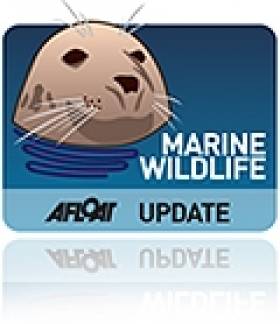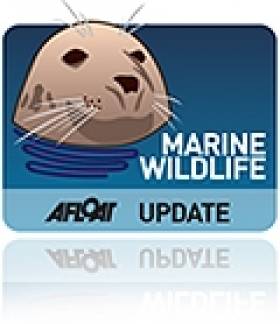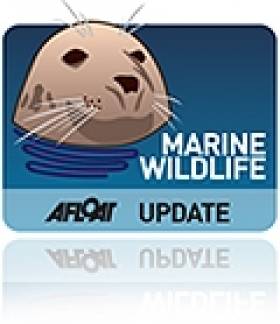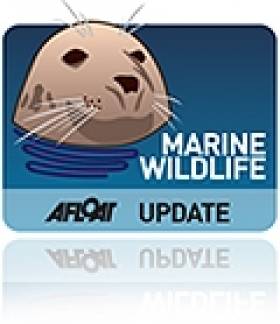Displaying items by tag: Whales
#MarineWildlife - Sharks have been filmed devouring a whale carcass at the ocean's surface in waters close to Britain and Ireland for the first time.
The results of the documentary expedition were broadcast last Friday as part of the UTV series Britain's Whales, available for catch-up the rest of this week.
As the Plymouth Herald reports, the groundbreaking experiment was headed by West Country marine biologist Dr Nicholas Higgs along with presenters Ellie Harrison and Ben Fogle, who sailed out to the Celtic Deep between Ireland, Cornwall and Wales with the carcass of a humpback whale in tow.
Their documentary crew were then able to film an "unprecedented" feeding frenzy by hundreds of blue sharks before the carcass was sunk for further study to examine the various creatures, from sharks to tiny 'zombie worms', that thrive on dead cetaceans as they drop to the ocean floor.
"I would never have predicted that you'd have this many sharks eating this much of the whale at the surface," said Dr Higgs. The Plymouth Herald has more on the story HERE.
In other cetacean news, Japan has disappointed global authorities by confirming hundreds of whale kills on its most recent expedition to the Antarctic.
Some 333 minke whales, including pregnant females, were poached between since December and last Friday (25 March), according to the Guardian.
As previously reported on Afloat.ie, Ireland recently joined an international demarche expressing "serious concern" at Japan's decision to resume whaling for what it claims are scientific purposes, claims that are not supported by the International Whaling Commission.
'Whale & Dolphin Trail' Proposed For Cork Coast
#MarineWildlife - Cork County Council has heard a proposal for a dedicated whale and dolphin trail along the county's coastline, as the Southern Star reports.
The Old Head of Kinsale, Mizen Head, Galley Head and Baltimore have already been identified as key locations for interpretive panels along the trail, the plans for which have had input from the Irish Whale and Dolphin Group (IWDG) and Fáilte Ireland, to tie in with the latter's Wild Atlantic Way initiative.
"A lot of people might think this is trivial, but it’s a huge tourism attraction around the world and whale watching in Co Cork is the best in Europe," said Cllr Christopher O’Sullivan. "It’s about time we realised this as it could have huge economic impact for the region."
The Southern Star has more on the story HERE.

New Revelations On Whale Communication
#MarineWildlife - Following yesterday's news that porpoises hunt by 'sound searchlight' comes this similarly remarkable video report from the BBC that reveals a new breakthrough in understanding how cetaceans communicate.
Studies by researchers at Washington, DC's Smithsonian Institution have identified specific differences between whales species types in the ways they navigate the oceans using sound – and they appear to be connected to the way they feed.
While toothed cetaceans such as porpoise and sperm whales echolocate using forward-focused beams of sound, some baleen whale species – the kind that sift plankton from the water for food – have a more radial perception due to the different position of their ears, shifted to accommodate their much wider mouths.
The discovery could be key to reducing the harmful effects of ocean noise on such marine wildlife caused by shipping traffic, the use of sonar and seismic surveys.
BBC News has more on the story HERE.
Interactive Video Sheds More Light On Humpback Whale Mystery
#MarineWildlife - The mysteries of Ireland's humpback whales have got the 'TouchCast' treatment as part of RTÉ's new interactive storytelling format.
As previously reported on Afloat.ie, scientists have recently tracked first the firm time ever whales travelling between popular spots on the Irish coast like Hook Head and feeding grounds thousands of miles way in the Arctic.
Now you can learn more about this new research in Philip Bromwell's TouchCast report, including cetacean experts' surprise at finding no matches between Irish whale and the popular breeding grounds in the mid Atlantic and the West Indies.
Another RTÉ TouchCast report worth watching pays a visit to the studios of Cartoon Saloon, nominated for an Oscar for their animated feature Song of the Sea that takes its inspiration from Irish maritime folklore.
#MarineWildlife - As protections on endangered whale species help buoy their numbers in the world's oceans, the chances of a blue-water encounter – while still slim – are getting better every year.
But at the same time grows the fear of a collision with one of these ocean giants that looms at the back of every offshore sailor's mind.
However, as Yachting World reports, there may be measures you can take to minimise that risk should you come in close quarters with a whale – or better yet, a whale pod.
Does painting the bottom of your boat in the colour red help? It turns out that it might make all the difference, as some scientific research suggests whales can perceive that colour in stark contrast to the rest of their environment, giving them a chance to swim around the vessel and keep danger at bay.
Speed is also an issue, with the vast majority of whale collisions occurring at speeds of over 14 knots – a trend that could be curbed by managing speed limits in whale-rich zones, plotting smarter courses or using dedicated on-deck observers.
Still the vast majority of encounters with whales are peaceful, even "dumbfounding" – but you don't want to startle them, as one group of divers off the island of Dominica learned when a sperm whale released its bowels right on top of them.
The Irish Mirror reports that the "poo cloud" is thought to be a defence mechanism – clouding the clear Caribbean water with a "poonado", as diver and photographer Keri Wilk described the 30-metre wide mass of waste.
"I had poop in my eyes, mouth, wetsuit, everywhere and I was soaked in it from head to toe," he said – though luckily it washed away quickly, bad smells and all!
Extreme Sportsman Dodges Sharks To Climb On Whale Carcass
#MarineWildlife - An extreme sports enthusiast has been lambasted for climbing onto the floating carcass of a whale while it was surrounded by sharks.
As Main Online reports, Perth man Harrison Williams was spotted by surprised onlookers swimming to the dead whale floating in the sea off Western Australia – despite it being circled by a number of tiger sharks and at least one great white shark.
"If sharks were feeding on that whale carcass when he swam over then that type of behaviour is highly risky," said Tony Cappelluti, regional manager with Western Australia's Department of Fisheries.
But Harrison shrugged off his critics, saying that "the whale looked in distress and I tried to help it. But clearly I was too late."
Mail Online has more on the story HERE.
'Boomerang' Sighting Marks Bumper Day For Whale Spotting In Celtic Sea
#MarineWildlife - The Irish Whale and Dolphin Group (IWDG) reports on a recent encounter with a humpback whale that's no stranger to our shores.
Marine mammal observer William Hunt was on the RV Celtic Explorer along the south coast where Cork meets Waterford last Wednesday 22 October when the boat came upon HBIRL3, better known as Boomerang.
This marked the first sighting of the distinctively marked male humpback since November 2012, and the ninth year he's been spotted since he was first recorded in August 2001.
The Boomerang sighting was just the tip of the iceberg on an eventful day for cetacean spotting on the annual Celtic Sea Herring Acoustic Survey, which included nine fin whales in various groups seen in close proximity.
The IWDG has much more on the story HERE.
Whale Poo Could Be Key To Combating Climate Change
#MarineWildlife - "What if whales were nature's ultimate geoengineers?" That's the question Philip Hoare poses on the Guardian's Comment Is Free section upon the news that US scientists have identified cetacean waste as a potentially pivotal link in the climate change chain.
Marine scientists from the University of Vermont compiled decades' worth of research in their new report that claims whale faeces – and deceased whales on the ocean floor – might comprise "massive carbon sinks" absorbing the CO2 human industry puts into the environment while also providing nutrients for other marine wildlife.
Indeed, it's now thought that areas where cetacean populations have shown signs of recovery after decades of hunting are also seeing "higher rates of productivity" among commercial fishing species.
The new report also supports the notion that climate change "may have been accelerated by the terrible whale culls of the 20th century" that removed a necessary balancing effect to counter the huge levels of man-made carbon emissions.
As Hoare writes: "A burgeoning global population of cetaceans might not just be good for the whalewatching industry, they may play a significant role in the planet's rearguard action against climate change."
The Guardian has much more on the story HERE.
Ireland's Coasts Are Waiting For Summer Whale Spotters
#MarineWildlife - Though the winter months comprise Ireland's major whale-watching season, this time of year brings more people to the coasts to witness Ireland's bounty of marine wildlife.
And if you're not sure where to look, BreakingNews.ie has a guide to some of the best opportunities for cetacean spotting.
Whether boating off Baltimore, kayaking off Kerry or simply hogging the binoculars from cliffs and headlands around our coasts, there's a good chance of sighting some of the many species of whales, dolphins and porpoise that call Irish waters home - or at least come to visit for a few months.
And that's not to mention our good friends the basking sharks, the ocean's second-largest fish, and the seal colonies that regularly entertain harbour-goers.
The guide also reminds potential spotters what to look out for, such as sudden reflections on the water, unusual vapour in the air, ripples against the current or seabirds going wild over a certain feeding spot.
If you're lucky, you may even have an encounter like the Ballyholme Yacht Club members who saw a humpback whale near the Copeland Islands in the North Channel recently, one of only a handful of sightings off the Co Down coast in the last 100 years.
Humpback Whale Feeding Frenzy Heralds A Winter Whale-Watching Bounty
#MarineWildlife - Humpback whales caught in a feeding frenzy off the Blasket Islands last week points to a potential bounty of big whale sightings over the winter months, as Nick Massett writes on the Irish Whale and Dolphin Group website.
A large aggregation of six humpback whales - a quarter of all those previously catalogued in the area - was witnessed feeding west of the Foze Rocks on Saturday 14 September.
Seven in total have been identified this year off the Blaskets, and with no sightings elsewhere around the Irish coast it's believed the humpbacks are content to feed exclusively within the Dingle Bay area for now.
Of course this is just the start of the big whale season, and the IWDG's Pádraig Whooley indicates that larger species such as the humpback and the commonly sighted fin whale - the longest ocean animal behind the elusive blue whale - are beginning to move inshore in greater numbers.
Even at that, inshore records "are likely to be the tip of a much larger iceberg", as imagery captured by the Irish Air Corps shows an incredible nine-strong group of fin whales feeding offshore along the Porcupine Blight where the water depth reaches more than 1km.
"But if this year pans out like previous years, the best has still yet to come," writes Whooley, "as historically the months November to January are the peak period for the "herring hog" inshore along the Irish south coast."
All this good news comes tinged with a some sadness, however, considering the rising trend of strandings of whales and dolphins on the Irish coastline - itself potential evidence of ill health among the whale and dolphin populations that visit our shores.


























